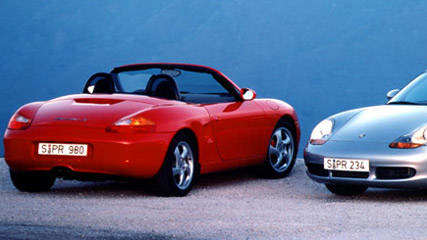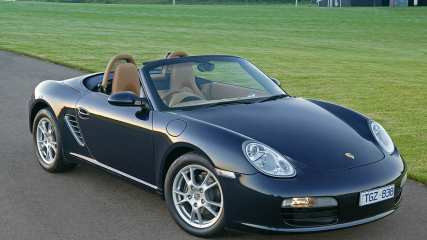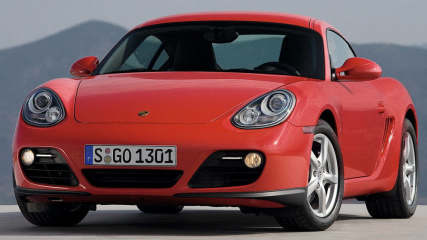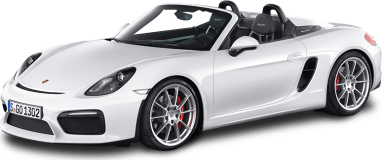Porsche Boxster and Cayman review: 1997-2012
By Ewan Kennedy · 15 Jul 2013
The Porsche Boxster and Cayman are pure mid-engined sports machines, meaning the engine is installed just behind the cabin, unlike the the engine in the Porsche 911 that’s fitted behind the back wheels.A mid-engine layout gives exceptionally good weight distribution and therefore the best in chassis balance and higher cornering speeds than the 911.Interestingly, the Boxster and Cayman share quite a few of their front-end components with the Porsche 911. At the rear they are quite different machine visually, though there’s still a family resemblance.Porsche Boxster is sold only as a convertible, Cayman is a fixed hardtop coupe and didn’t go on sale till 2006, nine years after its open-top brother.Boxster’s roof is one of the simplest in the business, note the clever way the roof acts as its own cover when it’s powered open. It can be left open even if the weather is threatening as it can easily be powered closed at a red traffic light. You can usually avoid the embarrassment of having to wait for roof closure to be complete after the lights turn green.Both models are brilliant machines that cry out to be pushed hard and fast. Their naturally-aspirated engines are wonderfully responsive, the gearbox is a delight to use, road grip is very high and the feel through the steering wheel and the seat of the pants is magnificent.It takes a lot of provocation to get the tail out of line, and if it does start to slide the cars remains controllable - up to a point, that is. As with all full-on sports cars with mid-mounted engines, if the tail gets out too far you'll need quick reflexes to correct it.An advanced driving course is recommended if you really want to get the best from your Porsche. These days electronics aids can save you from over-reaching; they can be detuned should you wish to make your own decisions, particularly for track days.Unlike the 911, these Porsches are strictly two-seaters. The seats are supportive and comfortable and shoulder room is plentiful, with the two occupants well insulated from buffeting with the roof down.A real bonus of the mid-engined layout is that Boxster and Cayman are surprisingly practical for sportscars, with luggage compartments front and rear, this can almost be used as a daily driver by a one or two-person household.The Boxster arrived in Australia in January 1997. It received minor upgrades in October 1999, August 2001 and August 2002, then a major upgrading in February 2005. The latter, tagged the 987 series, replaced the previous 986 models.This was upgraded again in November 2006, November 2007 and March 2009. An all-new Boxster came out in June 2012, followed by a new Cayman 12 months later.The Boxster was initially criticised for being down on power, mainly due to its smallish 2.5-litre, flat-six engine. That problem was solved in 1999 when a bigger 2.7-litre unit was installed.Even better news was the shoehorning of an optional 3.2-litre engine into the models called the Boxster S and Cayman S. This was increased to 3387 cc in 2006 and to 3436 cc in 2009, with the standard Boxster going up to 2.9 litres in 2009.These superb Porsche engines, even the smallest ones, really come alive above 4000 rpm, their tone initially hardening, then rising to a wonderfully metallic howl as it goes through 5000 rpm. Get the top down whenever you can and hold on to the lower gears just for the sheer pleasure of listening to it.There were major changes to the Boxster engine in 2009. Though the flat-six engines still capacities of 2.9 or 3.4 litres, they featured a direct injection fuel system.This was complemented by numerous other changes. Power was increased, and even more importantly peak torque remained constant over large parts of the rev band. Unlike the older powerplants, that needed 4000 revs to come on song, the newer units really begin to buzz from not much over 3000 rpm.Powerful ventilated brake discs are installed. If you think going from a standstill to 100km/h in under six seconds in the bigger engined models feels sensational, just wait until you experience 100 to zero in less than three seconds. That really makes your eyes bulge and gives a most satisfying feeling of security.Boxster initially used either a five-speed or six-speed manual gearbox or a five-speed Tiptronic automatic transmission. From the 2009 upgrade a seven-speed dual-clutch gearbox was installed.Porsche is long established in Australia. The dealer network isn’t huge, but it’s well organised and we seldom hear complaints about parts or service availability. Prices aren’t cheap, but neither are they outrageous for what you get.Insurance ratings are generally moderate for what is, after all, a prestige sports car aimed at those who like to drive hard and fast.A Porsche Boxster that’s always been serviced and repaired by an official dealer is relatively common and we feel it's the one to aim for. You probably be asked to pay more because of its history. And may we suggest you keep up the servicing to make your car a sound investmentWHAT TO LOOK FORHard driving is what the Boxster and Cayman are built for - butt too much can decrease their lives. Look for severe tyre wear, heavy brake dust buildup and repairs to the body. Rust is very unusual and almost certainly means the car has been badly repaired after a crash.These cars are well engineered and solidly built and unless poorly repaired after a crash should last well. If you suspect collision repairs it’s wise to have it professionally inspected.Check the interior for signs of mistreatment. Look under the floor mats for signs of dampness caused by a Boxster being caught out in the rain. The engine should start easily, idle smoothly virtually from the moment it kicks over and have throttle response that’s all-but instantaneous.Heavy operation of the clutch is likely to mean it’s due for an overhaul. Not a complex job, but there are no cheap repairs on a Porsche. The gearbox should be light and easy to use, with no noises at any time, even during the fastest of gearchanges.Be sure the brakes pull the car up cleanly without one wheel locking ahead of the others. If ABS is installed feel for a pulse through the brake pedal under hard braking.CAR BUYING TIPMost sports cars are only driven gently - sad but true - however it’s a fact of life they probably make a better used-car buy.













